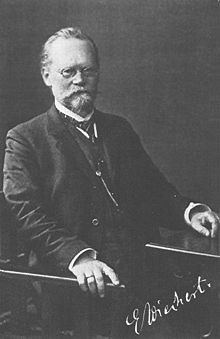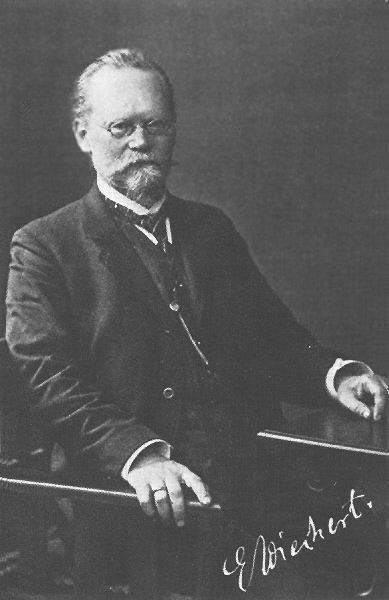Role Physicist Name Emil Wiechert | Institutions Germany Nationality German | |
 | ||
Alma mater University of Konigsberg, University of Gottingen Notable awards Berlin Academy of Science Died March 19, 1928, Gottingen, Germany Education University of Konigsberg (1890), University of Konigsberg (1889) Notable students | ||
Emil Johann Wiechert (26 December 1861 – 19 March 1928) was a German physicist and geophysicist who made many contributions to both fields, including presenting the first verifiable model of a layered structure of the Earth and being among the first to discover the electron. He went on to become the world's first Professor of Geophysics at the University of Göttingen.
Contents
- Sismografo de emil wiechert projeto de geologia
- Early years
- Career
- Contributions and Influence
- Awards and honors
- References

Sismografo de emil wiechert projeto de geologia
Early years
Wiechert was born in Tilsit, Province of Prussia, the son of Johann and Emilie Wiechart. After his father died, his mother, Emilie, moved to Königsberg so that Emil could study at the University of Königsberg. Owing to financial difficulties, he took longer than normal to complete his education and was finally awarded a Ph.D. on 1 February 1889. In October 1890 he received his Habilitation in Physics and by 1896, he had achieved the title of Professor.
Career
Whilst at Königsberg, Wiechert was investigating the nature of X-rays and became one of the first to discover that cathode rays are made up of particle streams. He correctly measured the Mass-to-charge ratio of these particles but failed to take the final step and explain that these particles were a new type of elementary particle - the electron. Wiechert was also interested in fields outside of fundamental physics and in 1896, he published the first verifiable model of the Earth's interior as a series of shells. Here he concluded that the difference between the density of the Earth's surface rocks and the mean density of the Earth meant that the Earth must have a heavy iron core. These were the foundations that one of Wiechert's students, Beno Gutenberg, used to discover the three-layered Earth in 1914.
As part of Felix Klein's efforts to re-establish the University of Göttingen as a world leading research centre, Wiechert's tutor, Woldemar Voigt, was lured away from Königsberg and took Wichert with him. He had initially hoped to become a Professor of theoretical physics but was eventually invited by Klein to found the world's first Institute of Geophysics, becoming the world's first Professor of Geophysics in 1898. He would remain there for the rest of his career, mentoring many students who became world-leading geophysicists and seismologists, including Karl Bernhard Zoeppritz and Beno Gutenberg.
Contributions and Influence
During his career he made many other important contributions, writing a number of scientific papers, including a pioneering work on how seismic waves propagate through the Earth. He also devised an improved seismograph and created the field of geological prospecting using small, artificially-created earthquakes. Wiechert was also interested in theoretical physics, such as the theory by Albert Einstein. He discussed the role of the ether and related questions with Hendrik Antoon Lorentz and others. Wilfried Schröder has published the scientific correspondence between Lorentz and Wiechert, Arnold Sommerfeld and Wiechert and has presented a biography of Wiechert (Bremen, Science Edsition, 2000).
He married Helene Ziebarth, a lawyer's daughter, in 1908, but the couple did not have children.
